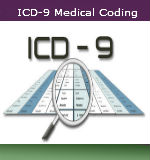ICD-9 Medical Coding Process of Elimination
Q: Hello, do you have a Blitz process of elimination for ICD-9 questions? Seems there is a process for this, I hear. Thank you – Leticia.
As many of you already know if you come to one of our webinars before, I really enjoy ICD-9. Laureen is the CPT Guru because she actually had to deal with billing more than I’ve ever had to deal with, and I like diagnosis. I like diseases and I like the disease process and learning about them. This is a fun question for me. Let’s go see what I’ve decided to write.
ICD 9 Medical Coding Process of Elimination Part 1 – Video

When you sit down to break ICD questions in an exam, there is a few quick tips that I like to tell you. There are key words that are going to tell you navigate – acute, chronic, acute and chronic, and due to. If you see those words, then you know that that’s pertinent to the codes that you’re going to use. So those codes should just absolutely jump off the page when you’re looking at a report. Now, some examples of that: you got acute pericarditis, unspecified (420.90). What if you had something else, let’s see 423.8 – other specified diseases of the pericardium. Then, which would be like chronic pericarditis, but what if you had acute and chronic pericarditis? Look, you would use both codes 420.90 and 423.8.
Let’s take another example: let’s say, most codes that are acute and chronic, they’re going to have their own code to go with that. When you look up in the index for chronic pericarditis, the index of your manual is going to tell you the code is 423.8, but when you go in to the tabular is going to say other specified diseases of the pericardium – which means chronic pericarditis is that, chronic pericarditis will not be listed in the tabular, but it is listed in the index. You have to trust the index that that’s the proper code. So there’re two codes for those two separate conditions.
But there are codes that can be acute and chronic at the same time, and respiratory failure is one of those. If you go look at 518.84, it will say acute and chronic respiratory failure. So, see how important is to know if it’s a chronic condition or an acute condition, and if it’s acute and chronic. A little tidbit, know that acute codes are listed first, if there’s two different ones. So, if your person has acute and chronic pericarditis, acute will be listed first because that’s more severe. It’s an acute, it happens suddenly, onset. Also, there’s some little excludes there, I left it there.
Now, “due to” or “late effects’. Let’s look at 438.11 late effect of cerebrovascular disease; aphasia. So what they’re saying, your patient came in and they have aphasia. Why do they have aphasia? Because they had a CVA. That code explains that, 438.11 means your person has aphasia. Why do they have aphasia? Because of a previous CVA. So, one code took care of both of those terms.
Now, let’s look at classifications that are only 3 digits. All of these codes up here, notice that they’re 4 and 5 digits because they can be more specific; thus, we’re switching to ICD-10 because we can’t be any more specific, but yet, our education has increased and the diseases we know more about them and so we need more digits. But there are still some codes that only need3 digits and one of those is pneumonia. You don’t know what type of pneumonia it is; it’s 486 – that explains it all. Now, unless you have that memorized and you’re never supposed to just memorize codes, but if you’re dealing with codes over and over again, you will memorize them.
So when I look at these three codes, I automatically know because I deal with them daily that these are three digit codes that don’t need any more classification or description. Pneumonia, if I don’t know what type of pneumonia it is, it doesn’t tell me if it’s viral or bacterial, I know it’s 486. That explains it all, 3 digits. What about a person that had an old MI, it’s 412. As long as it’s more than eight weeks old, it’s a 412 and I don’t need any more explanation on that. Or COPD, it’s 496. Three numbers, that’s all it takes, and that explains the situation. Now, there are not very many that are just 3 digits, but those are three of the most common that I know. There’s more out there, I’m sure.
![[CCO] Certification Coaching Organization LLC [CCO] Certification Coaching Organization LLC](https://www.cco.us/wp-content/uploads/2015/05/CCO-Logo-2015-d3-500px.png)
